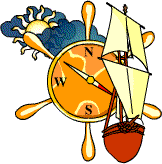The Mary Celeste
Created | Updated Nov 24, 2013

On the 7 November, 1872, Captain Benjamin Briggs set sail from New York on a routine journey across the Atlantic. A robust 37 year old from New England, Briggs was an experienced Captain and had made many trips to Europe before. He was travelling with his wife, Sarah, and their two year old daughter.
The Ship
The Mary Celeste was a 12 year old brigantine1 originally called Amazon. It was 103 feet long and weighed 280 tons. Briggs was part owner of the vessel which had been purchased at an auction for $3,000 and had undergone extensive repairs. When it set sail in November, the craft was carrying 1,700 barrels of alcohol. This was in effect only a half load, but Briggs had every reason to expect a healthy profit on arrival in Genoa, Italy.
The Voyage
On the 15 November another brigantine, the Dei Gratia, set sail from New York. This was a British owned vessel, and Captain Morehouse was a friend of Benjamin Briggs. The two men had met up briefly before the Mary Celeste had departed, and both ships were bound for Europe.
The voyage of the Dei Gratia passed smoothly for the first two weeks. Then, on 4 December, the crew spotted another ship drifting aimlessly off the coast of Portugal. Captain Morehouse signalled the vessel, but there was no response. The Dei Gratia drew closer and Morehouse was alarmed to discover that the ship belonged to Captain Briggs. It was the Mary Celeste.
The Mystery
The craft was boarded and found to be completely deserted. The crew had apparently abandoned ship some nine days earlier. The life boat was gone and the brigantine had drifted some 700 miles from the last point recorded in the ship's log. A final entry, written in draft form on the 25 November, detailed a minor course correction: 'At 8 eastern point bore SSW 6 miles distant'.
Captain Morehouse could find no logical reason why the ship had been abandoned. Though some water had seeped in at the bottom of the craft, the Mary Celeste had suffered no serious structural damage. There was plenty of food and water on board - six months supply, in fact. According to the log, no-one had suffered any ill-health or mental disturbance. Since the cargo was fully intact, apart from one barrel of alcohol which had been slightly damaged, piracy was also ruled out. To leave a perfectly healthy ship mid-voyage and to take your chance in a small life boat in the middle of the Atlantic seemed the height of lunacy.
Nonetheless, sometime on the 25 November, 1872, Captain Briggs, his wife, their daughter, and the eight-strong crew had indeed abandoned ship. They were never to be seen again.
A skeleton crew was placed aboard the Mary Celeste and the vessel arrived in Gibraltar alongside the Dei Gratia on 13 December. An enquiry was held into the affair. The British officials in Gibraltar were suspicious of Captain Morehouse, suspecting that he might be in league with Briggs in some kind of fraudulent salvage claim. There was no evidence to justify this suspicion, however, and despite intensive questioning none of the men who had boarded the ship were able to cast any light on the mystery. The enquiry ended without a firm conclusion, and Morehouse received his dues for the recovery of the vessel.
The Theories
In the time since its abandonment, many theories have been put forward to explain what happened on board the Mary Celeste.
The initial hypothesis, that Briggs had somehow planned to abandon the ship in collusion with Morehouse, has been discounted by many people. The fact that neither Briggs nor his family were ever heard from again make allegations of fraud somewhat spurious.
Another suggestion is that the vessel was struck by a ferocious storm. While this would certainly explain the three and a half feet of water discovered in the hold, the ship was not badly damaged and it would have been foolhardy to abandon it on the off-chance that it might suffer further damage.
Other commentators have drawn attention to the food on board ship. The bread being eaten on the Mary Celeste was made from rye rather than wheat. Rye, when wet, breeds a kind of fungus which causes blindness and insanity when ingested. This theory suggests that the half-crazed crew crammed themselves into the lifeboat and abandoned ship, happily leaving most of their possessions behind them.
Insanity is at the root of another theory, which suggests that a mental disturbance was caused by fumes rising up from poorly stored barrels of alcohol. It was certainly the first time Briggs had carried such substances and it may be that he did not take sufficient precautions.

The Ending
Whatever the truth, it seems almost certain that the crew died shortly after leaving their ship. The unfortunate sailors were too far from land and had too little by way of supplies to have much chance of survival in the mid-Atlantic.
Remarkably, the Mary Celeste endured and continued in service for a further 11 years. It was eventually abandoned in the West Indies and met its demise - appropriately enough - at the hands of the ocean itself.
The Fiction
In 1884, Arthur Conan Doyle wrote a story for Cornhill Magazine entitled Habakuk Jephson's Statement. It concerned a fictional ship, the Marie Celeste, and mixed many of the true facts of the case with some of his own invention2. It was this story that fixed the mystery in the minds of the public, and ensured that the Mary Celeste and its unfortunate crew had a life beyond their watery grave.

